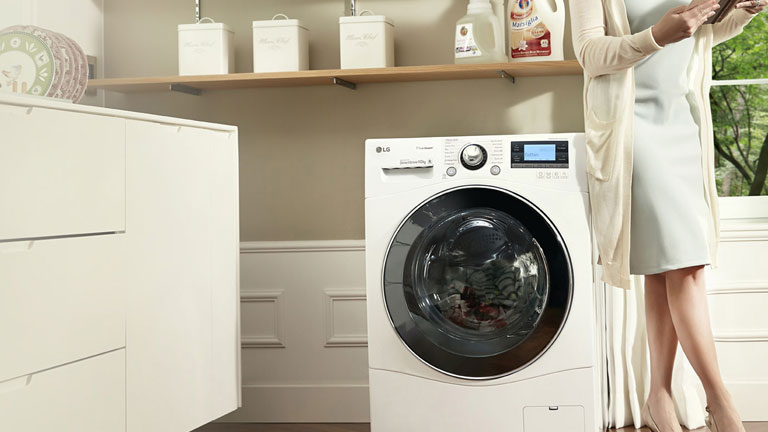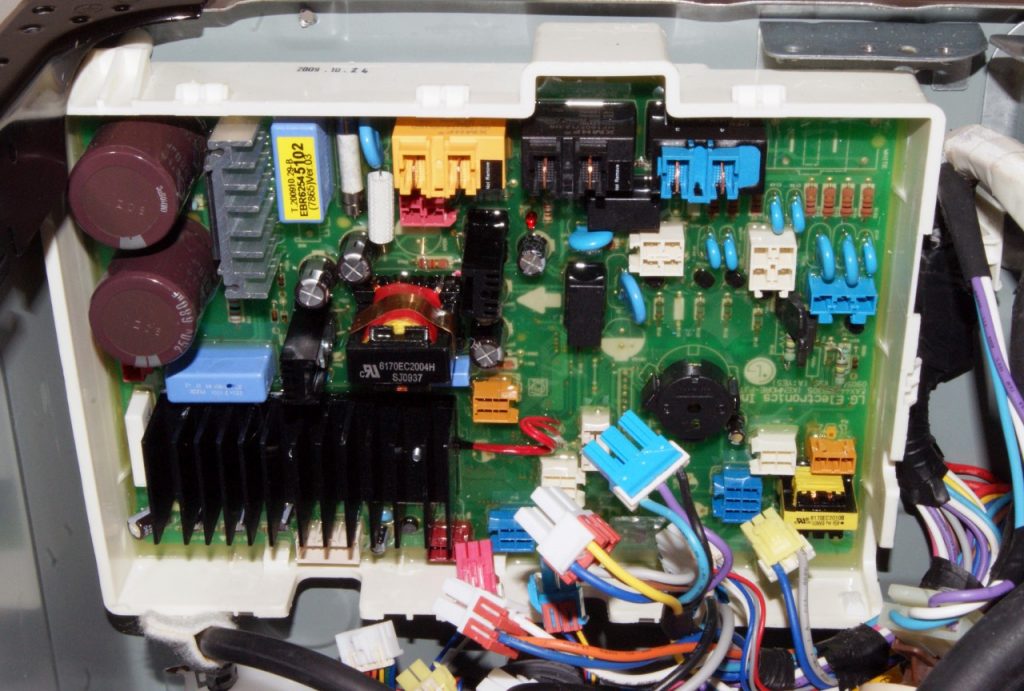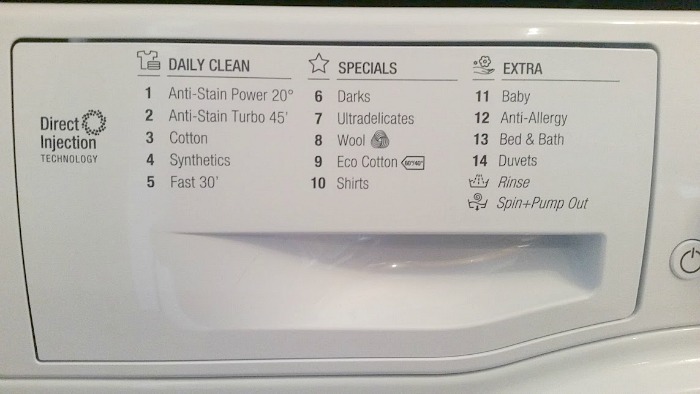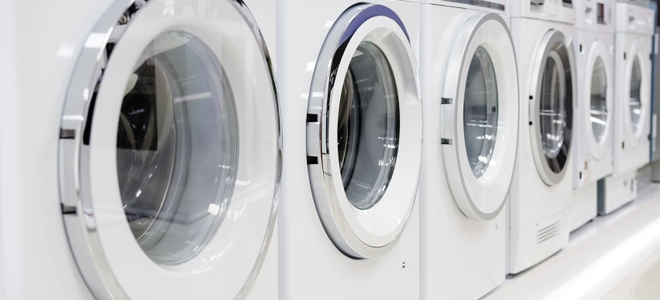There are many criteria of choice of washing machines:
- Type of loading
- Size
- Capacity
- Engine (inverter or direct drive)
- Spinning speed
- Tank and drum material
- Control type
- Washing programs
- Additional options: classes of washing, spinning and energy efficiency, device security and noise level
All these criteria are important, and every buyer must consider them, choosing a washing machine.
First one – loading type. So we’ll start with it.

Loading type
There are two types of washing machines: front and top load. Devices with front load are more popular and common. Laundry load into the drum from the side of the device, so it can be used as a small decorative table in the bathroom or kitchen – an additional place for keeping some things. Top-loaded washing machine doesn’t give you such opportunity, so its construction is the first shortcoming. Additional usable space is very important in small bathrooms and kitchens, so front-loading washing machines have priority of using here.
Some words about reliability. Many experts talk about improved reliability of top-loaded washing machines because of using in the two bearings (in front load washing machines always uses one bearing), so drum mounted stronger as a result. In defiance of this belief, both types of washing machines have a long life under normal use. However, there is a small minus of the machine with front loading – hatch, which requires extra space when opened.
Dimensions of the washing machine
This is the other one criterion of choosing. The main parameter here is a depth. That it allows you to choose the model which will fit in the allotted place in the apartment. The height and width of most washing machines with front-loading the same: about 85 cm and 60 cm, respectively. Rare you can find washing machines with a depth of 33 to 39 cm (also called super narrow), as well as narrow models with depths ranging from 40 to 49 cm. Devices with the depth from 50 to 59 cm or a little more than 60 cm (generally up to 62 cm) are called full-length.
Also, there are compact washing machines with front type of loading. Their height is about 70 cm, which allows to set them under the sink. Their width is typically about 50 cm, and depth – 44-47 cm. As for top-loading washing machines, the diversity of the dimensions isn’t so widespread. Their height normally about 85-90 cm, width – 40 cm, and depth – 60-65 cm.
Capacity
Another very important point – the amount volume of laundry that washing machine can wash for a cycle. Capacity is directly related to its dimensions. Models of smaller size usually contain less, although recently the trend – increase the capacity of small size machines. First of all, it concerns the most popular in our country narrow washing machines. Many of them already contain 7-8 kg of laundry while more recently such loading was available only for the full-size models.
Front-loading washing machines with 3-4 kg refer to compact models. Available and more capacious: 4-5 kg, 5-6 kg, 6-7 kg, as well as models with a load of more than 7 kg.
Top-loading devices don’t have such amount of capacity options. These models usually can wash 5-7 kg of cotton items. Remember that manufacturers in the characteristics always indicate maximum load for cotton items. If you need to wash woolen clothes the maximum rate of loading is usually less (details always have in the instruction manual).
If your family large you need a capacious washing machine, but if you live alone buying such a device isn’t logically. But if you plan to wash large sings as coverlets, you need to match them with the weight capacity of washing machine. This parameter always indicated in technical documentation of the device.
Engine (Inverter or Direct drive)
In recent years the range of washing machines with inverter motor (asynchronous) significantly expanded. The inverter converts the constant voltage into a three-phase (or single-phase) variable pulsed voltage of changing amplitude and frequency. Such engines are modern, they work quieter than conventional and they have higher efficiency and longer service life. They provide wider possible range of drum rotation algorithms, and it makes the quality of the wash better.
The rotor of a direct drive motor mounted on the drum shaft. Torque at once without a “mediator” in the form of a belt transferred to the drum. Absence drive belt means that it does not stretch (for example, if the device overloaded). Also, the useful energy doesn’t waste for overcoming the friction force of the belt. In general, such a structure is more durable, economical, less noisy. In addition, the location of the washing machine engine minimizes tank fluctuations. Direct drive motor may also have an inverter circuit work.
Spinning speed
Washing machines spin speed varies in a large range. There are models with speed 600 – 800 drum revolutions per minute, 800 – 1000 rpm, 1000 – 1200 RPM, 1200-1400 RPM, and even up to 1600 rev/min.
Modern automatic models usually can provide an opportunity to select the preferred spin speed (not only the maximum) or completely cancel the spin cycle – the wash of certain things is contraindicated. In general, for a quality spin, most things quite enough speed 800-1000 rev/min.
Higher speed always increases the cost and often they are not needed, except that, if you often wash terry things or if you have limited time.
Tank and drum material
A few years ago it was thought that the washing machines tank (washing drum installed there, it receives water) must be metal. But today this is not true – a variety of modern plastic and composite materials replace metal with success. Metal tanks are only used with some premium class models. Today a lot of washing machines have plastic tank because of less level of noise, less weight and cheapness. Also, there is no negative influence of using such tanks. Device with a plastic tank will work at least 10 years. But the drum, which is used in automatic washing machines, is always made of steel.
Manufacturers are adopting various “drum” innovations to improve performance wash – to make it more gentle without loss of washing quality. For example, they release drums with internal cell surfaces. It makes a thin interlayer between clothes and the drum and provides more delicate washing. Also produce drums with teardrop lugs, which provide gentle but efficient mechanical action.

Control type
Most automatic washing machines now equipped with electronic control. The display and buttons, or sensors – is no longer a novelty, even for relatively low-cost models. The big plus of the electronic control – improved variability of settings. Only electronic control allows the machine to create a truly optimal algorithm for the washing of the loaded things. Some models with electronic control can “remember” created by user algorithm (or several) washing: water temperature, number of rinses, spin speed. After that, it can be started with a single click.
Electronic control
Electronically controlled models are also available for software upgrades – up to memorize new washing programs. In addition, such control allows remote monitoring operations of the washing machine (with a smartphone or tablet, for example) via a downloaded application, as well as Wi-Fi or Bluetooth. These functions are available not in all washing machines with electronic control, but the trend is that the number of such devices increases. For example, the lines Candy and Samsung offer models with remote monitoring function.
Models with electronically-mechanically control are cheaper and give the user fewer opportunities for a variety of wash options. In fairness, we note that this control provides the most important functions and that is enough. In addition, electronically-mechanically control carried by turning knobs, switches, which for many people is more convenient and clearer than, for example, advanced sensors. But also electronically controlled models can have a turning programmer – this is familiar for users.
Washing programs
Any automatic washing machine has a core set of wash programs. It includes different temperature cycles for cotton items, a program for synthetics wash, cycle for things made of wool, “hand-washing”. It is also desirable to have an intensive washing mode (for very dirty things) and a separate cycle for delicate items that require a very gentle wash cycle. At least washing machine needs one short program that allows washing not too dirty things.
These programs will be enough for everyday washing needs. The rest is an additional convenience, which simplifies user life. It is also desirable to be accessible selections of water temperature for the majority of programs.

Washing machines additional options
Very handy timer that allows set aside washing at night, when electricity tariffs are lower. This option is useful for the budget conscious user.
Another useful thing, especially for people with allergies, – extra rinse. That is the possibility to increase their number in the wash programs that will help to completely remove detergent from the fabric.
Option ‘Easy Ironing’ is not available in all devices. After washing with this option on things have fewer folds. It facilitates the subsequent ironing. Achieving this effect suggests things are erased with large quantity of water, and the intermediate spin may be avoided.
Another useful option is – “Night Wash” with excluded spin – the noisiest stage washing – not only intermediate but also the final. In the morning, users are free to include spinning or, if it is not needed (for some things it is so), he can drain and unload the washing machine. This feature is particularly relevant for small apartments, where the noise can actually prevent sleep owner or children (in modern prefabricated homes it can prevent neighbors too).
Electronically controlled models have automatic weighing. This is a good thing to determine optimum washing algorithm. The device weighs the number of things, and “does conclusions” (depending on the type of fabric and other settings) and determines how much water to use, how long to wash, what speed spin to use and so on.
Recently gaining popularity so-called dry steam. The idea is that the laundry in the process exposed also steaming that serves as its decontamination and improve the quality of the wash. There are models of washing machines, offering steaming cycles without water (steam only): to refresh clothes, removing extraneous odors. Particularly active steam laundry introduced by the South Korean manufacturer LG Electronics.
If there are children in the family, who are often inadvertently put on clothes stains, look for models with special spotting systems. In the modern version, the user simply selects the type of stain, and then the machine will do everything herself; stain should disappear by the end of the wash. Hotpoint-Ariston, Siemens offer such models.
Another interesting point – the possibility of washing time reducing. The user can select the desired wash time (for example, he can reduce the duration of the standard program), and the machine will build a wash algorithm, considering installed time.
Useful thing – sound notification about the end of the wash. If the device has such a function, you will not forget to pull out of the drum clean linen. But make sure you can disable the sound. If washing ends at night, it can make wake up everyone.
Classes of washing, spinning and energy efficiency
The vast majority of modern automatic front and top load washing machines has the highest indicator of quality of washing – class A. Models that wash only slightly worse (regular user will notice the difference), is assigned to washing Class B. But find them quite difficult, not to mention the models of the class C or D.
Washing class is determined by results of the special test – the so-called reference wash with a water temperature of 60 ° C with the same (for all brands of machines) detergent. The parameters are defined by international standards. Class spin washing machine is also referred by letters from A (highest) to B (slightly worse), C, D, E, etc. In total, seven classes… The lower the humidity of the laundry after the spin, the less time it will take the subsequent drying and the higher the spinning class. However, if the spinning class, for example, B or C, this does not mean that the laundry after washing will dry much longer – the user often cannot see the difference.
Energy efficiency class allows you to evaluate the efficiency of the washing machine. In total there are 9 classes of energy consumption, from, A +++ to G. Note that the energy efficiency class of washing machines with dryer is always lower than normal: air heating – the process is fairly energy-intensive. Remember also that the highest electricity consumption depends on water heats up to high temperatures. Low-temperature washing is more economical!

Device security
For maximum safety wash manufacturers implement in their washing machines various technical solutions. If there is a small child in your home you have to choose a washing machine with lock control panel function. So you eliminate the possibility of changing the wash settings, accidental turn on or off. Models with electronic control always have this function.
Flud – the most important moment. It is good if the machine is protected from leakage completely (body and hoses). But there are models where implemented only partial protection against leaks – usually the case. However, protected dual hoses are always available for purchase separately (and other accessories), and they can be used with the most modern washing machines.
Modern washing machines have overfill protection – when excess water is fixed in the tank, the drain pump turns on immediately. Also, they are protected from the drum imbalance that occurs during the spin cycle (the machine tries to distribute the things inside it evenly).
Noise level
Spin – the noisiest washing stage. So you should be interested in a maximum noise level that produces a washing machine performing this operation. Not all manufacturers indicate it; often can be specified noise during washing, and it is significantly lower. It is advisable to purchase a model, in which the figure does not exceed 70 dB. The noise level in the wash should not be higher than 55-56 dB.
Perhaps it’s all the criteria for selecting the washing machine.
